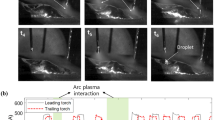Abstract
It is essential to sense the deviation of weld seam real timely in robotic welding process. However, welding process always accompanied with high temperature, strong arc light, and background noises, which significantly affects the application of sensors. In this study, a novel acoustic sensor was developed. This sensor consists of two microphones. Based on the sound signals collected by these two microphones, the deviation of weld seam was detected. The frequency response of the developed acoustic sensor was studied through simulation method firstly, and then, the sensing performance of it was analyzed with experiments. The experimental results show that the developed acoustic sensor has a linear property for the deviation detection of V-groove weld seam. This research provides a novel method for weld seam tracking.




source frequency is 2001 Hz. (b) Sound source frequency is 6201 Hz. (c) Sound source frequency is 11601 Hz. (d) Sound source frequency is 17201 Hz


source in the center of weld seam. (b) Sound source at the right side of weld seam



















Similar content being viewed by others
References
Presern S, Gyergyek L (1983) An intelligent tactile sensor-an on-line hierarchical object and seam analyzer. IEEE Trans Pattern Anal Mach Intell 2:217–220
Lei T, Huang Y, Shao W et al (2020) A tactual weld seam tracking method in super narrow gap of thick plates. Robot Comput Integr Manuf 62. https://doi.org/10.1016/j.rcim.2019.101864
Kim CH, Na SJ (2001) A study of an arc sensor model for gas metal arc welding with rotating arc Part 1: dynamic simulation of wire melting. Proc Inst Mech Eng Part B J Eng Manuf 215:1271–1279. https://doi.org/10.1243/0954405011519321
Shi YH, Yoo WS, Na SJ (2006) Mathematical modelling of rotational arc sensor in GMAW and its applications to seam tracking and endpoint detection. Sci Technol Weld Join 11:723–730. https://doi.org/10.1179/174329306X153196
Kodama S, Ichiyama Y, Ikuno Y, Baba N (2006) Arc sensor sensitivity in short circuiting metal active gas welding with high speed torch oscillation. Sci Technol Weld Join 11:25–32. https://doi.org/10.1179/174329306X77867
Gao Y, Zhang H, Mao Z (2009) Fillet welding seam tracking based on a mobile robot with rotational arc sensor. Jixie Gongcheng Xuebao/Journal Mech Eng 45:64–71. https://doi.org/10.3901/JME.2009.09.064
Chen SB, Zhang Y, Qiu T, Lin T (2003) Robotic welding systems with vision-sensing and self-learning neuron control of arc welding dynamic process. J Intell Robot Syst Theory Appl 36:191–208. https://doi.org/10.1023/A:1022652706683
Wu QQ, Lee JP, Park MH et al (2015) A study on the modified Hough algorithm for image processing in weld seam tracking. J Mech Sci Technol 29:4859–4865. https://doi.org/10.1007/s12206-015-1033-x
Jia Z, Wang T, He J et al (2020) Real-time spatial intersecting seam tracking based on laser vision stereo sensor. Meas J Int Meas Confed 149:106987. https://doi.org/10.1016/j.measurement.2019.106987
Lee SK, Na SJ (2002) A study on automatic seam tracking in pulsed laser edge welding by using a vision sensor without an auxiliary light source. J Manuf Syst 21:302–315. https://doi.org/10.1016/s0278-6125(02)80169-8
Chen H, Lin T, Chen S (2011) Seam tracking and dynamic process control for high precision arc welding. In: Robotic Welding, Intelligence and Automation. pp 193–201
Xu Y, Fang G, Chen S et al (2014) Real-time image processing for vision-based weld seam tracking in robotic GMAW. Int J Adv Manuf Technol 73:1413–1425. https://doi.org/10.1007/s00170-014-5925-1
Song S, Chen H, Lin T et al (2016) Penetration state recognition based on the double-sound-sources characteristic of VPPAW and hidden Markov Model. J Mater Process Technol 234:33–44. https://doi.org/10.1016/j.jmatprotec.2016.03.002
Lv N, Xu Y, Li S et al (2017) Automated control of welding penetration based on audio sensing technology. J Mater Process Technol 250:81–98. https://doi.org/10.1016/j.jmatprotec.2017.07.005
Zhang Z, Wen G, Chen S (2018) Audible sound-based intelligent evaluation for aluminum alloy in robotic pulsed GTAW: mechanism, feature selection, and defect detection. IEEE Trans Ind Informatics 14:2973–2983. https://doi.org/10.1109/TII.2017.2775218
Gao Y, Zhao J, Wang Q et al (2020) Weld bead penetration identification based on human-welder subjective assessment on welding arc sound. Meas J Int Meas Confed 154:107475. https://doi.org/10.1016/j.measurement.2020.107475
Lan H, Zhang H, Chen S et al (2014) Correlation of arc sound and arc-sidewall position in narrow gap MAG welding. Chinese J Mech Eng 50:38–43
Liu W, Guan Z, Jiang X et al (2019) Research on the seam tracking of narrow gap P-GMAW based on arc sound sensing. Sensors Actuators A Phys 292:205–216. https://doi.org/10.1016/j.sna.2019.04.015
Na L, Gu F, Yan-ling X et al (2017) Real-time monitoring of welding path in pulse metal-inert gas robotic welding using a dual-microphone array. Int J Adv Manuf Technol 90:2955–2968. https://doi.org/10.1007/s00170-016-9571-7
Funding
This work was supported by National Natural Science Foundation of Shanghai (21ZR1425900).
Author information
Authors and Affiliations
Contributions
Yanfeng Gao: Conceptualization, Methodology, Writing-original draft preparation, Funding acquisition. Jianhua Xiao: Investigation, Data curation, Visualization. Genliang Xiong: Writing-review and Editing. Hua Zhang: Supervision, Project administration.
Corresponding authors
Ethics declarations
Ethics approval
Not applicable.
Consent to participate
All the authors listed have participated in the preparation of the manuscript.
Consent for publication
This manuscript is approved by all the authors for publication. It is the original research that has not been published previously, and not under consideration for publication elsewhere, in whole or in part.
Conflict of interest/Competing interests.
The authors declare no competing interests.
Additional information
Publisher's Note
Springer Nature remains neutral with regard to jurisdictional claims in published maps and institutional affiliations.
Rights and permissions
About this article
Cite this article
Gao, Y., Xiao, J., Xiong, G. et al. Research on the deviation sensing of V-groove weld seam based on a novel two channel acoustic sensor. Int J Adv Manuf Technol 119, 5821–5837 (2022). https://doi.org/10.1007/s00170-021-08454-9
Received:
Accepted:
Published:
Issue Date:
DOI: https://doi.org/10.1007/s00170-021-08454-9




